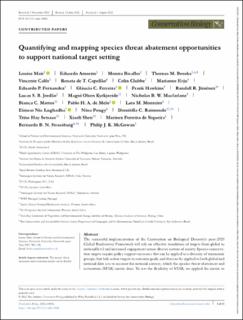| dc.contributor.author | Mair, Louise | |
| dc.contributor.author | Amorim, Eduardo | |
| dc.contributor.author | Bicalho, Monira | |
| dc.contributor.author | Brooks, Thomas M. | |
| dc.contributor.author | Calfo, Vincente | |
| dc.contributor.author | Capellão, Renata de T. | |
| dc.contributor.author | Clubbe, Colin | |
| dc.contributor.author | Evju, Marianne | |
| dc.contributor.author | Fernandez, Eduardo P. | |
| dc.contributor.author | Ferreira, Gláucia C. | |
| dc.contributor.author | Hawkins, Frank | |
| dc.contributor.author | Jiménez, Randall R. | |
| dc.contributor.author | Jordão, Lucas S.B. | |
| dc.contributor.author | Kyrkjeeide, Magni Olsen | |
| dc.contributor.author | Macfarlane, Nicholas B. W. | |
| dc.contributor.author | Mattos, Bianca C. | |
| dc.contributor.author | de Melo, Pablo H.A. | |
| dc.contributor.author | Monteiro, Lara M. | |
| dc.contributor.author | Lughadha, Eimear Nic | |
| dc.contributor.author | Pougy, Nina | |
| dc.contributor.author | Raimondo, Domitilla C. | |
| dc.contributor.author | Setsaas, Trine Hay | |
| dc.contributor.author | Shen, Xiaoli | |
| dc.contributor.author | de Siqueira, Marinez Ferreira | |
| dc.contributor.author | Strassburg, Bernardo B. N. | |
| dc.contributor.author | McGowan, Philip J. K. | |
| dc.date.accessioned | 2022-12-20T09:39:15Z | |
| dc.date.available | 2022-12-20T09:39:15Z | |
| dc.date.created | 2022-12-14T14:54:10Z | |
| dc.date.issued | 2022 | |
| dc.identifier.issn | 0888-8892 | |
| dc.identifier.uri | https://hdl.handle.net/11250/3038765 | |
| dc.description.abstract | The successful implementation of the Convention on Biological Diversity’s post-2020Global Biodiversity Framework will rely on effective translation of targets from global tonational level and increased engagement across diverse sectors of society. Species conserva-tion targets require policy support measures that can be applied to a diversity of taxonomicgroups, that link action targets to outcome goals, and that can be applied to both global andnational data sets to account for national context, which the species threat abatement andrestoration (STAR) metric does. To test the flexibility of STAR, we applied the metric to vascular plants listed on national red lists of Brazil, Norway, and South Africa. The STARmetric uses data on species’ extinction risk, distributions, and threats, which we obtainedfrom national red lists to quantify the contribution that threat abatement and habitatrestoration activities could make to reducing species’ extinction risk. Across all 3 coun-tries, the greatest opportunity for reducing plant species’ extinction risk was from abatingthreats from agricultural activities, which could reduce species’ extinction risk by 54% inNorway, 36% in South Africa, and 29% in Brazil. Species extinction risk could be reducedby a further 21% in South Africa by abating threats from invasive species and by 21% inBrazil by abating threats from urban expansion. Even with different approaches to red-listing among countries, the STAR metric yielded informative results that identified wherethe greatest conservation gains could be made for species through threat-abatement andrestoration activities. Quantifiably linking local taxonomic coverage and data collection toglobal processes with STAR would allow national target setting to align with global targetsand enable state and nonstate actors to measure and report on their potential contributionsto species conservation. habitat restoration, national red lists, species’ extinction risk, threat reduction, threatened species, vascular plants | en_US |
| dc.language.iso | eng | en_US |
| dc.rights | Navngivelse 4.0 Internasjonal | * |
| dc.rights.uri | http://creativecommons.org/licenses/by/4.0/deed.no | * |
| dc.title | Quantifying and mapping species threat abatement opportunitiesto support national target setting | en_US |
| dc.title.alternative | Quantifying and mapping species threat abatement opportunitiesto support national target setting | en_US |
| dc.type | Peer reviewed | en_US |
| dc.type | Journal article | en_US |
| dc.description.version | publishedVersion | en_US |
| dc.rights.holder | © 2022 The Authors | en_US |
| dc.subject.nsi | VDP::Zoologiske og botaniske fag: 480 | en_US |
| dc.subject.nsi | VDP::Zoology and botany: 480 | en_US |
| dc.source.journal | Conservation Biology | en_US |
| dc.identifier.doi | 10.1111/cobi.14046 | |
| dc.identifier.cristin | 2093253 | |
| dc.relation.project | Andre: Global Environment Facility | en_US |
| dc.relation.project | Andre: Newcastle University | en_US |
| dc.relation.project | Andre: International Union for the Conservation of Nature | en_US |
| dc.relation.project | Egen institusjon: Norwegian institute for nature research (NINA) | en_US |
| cristin.ispublished | true | |
| cristin.fulltext | original | |
| cristin.qualitycode | 2 | |

